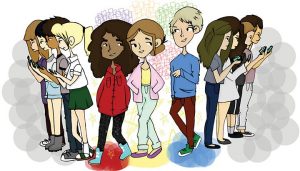Recent project by New Tech City and NPR relate cell phones
to the downfall of boredom and creativity
The average American checks his or her cellphone over 150 times a day, but 67 percent of the time, the phone isn’t vibrating or ringing – according to the Bored and Brilliant project conducted by WNYC, the national public radio station in New York City. If you do the math, that’s almost every 10 seconds in a 24-hour period.
And it gets worse. Here at Hockaday, students check their phones every 5 to 6 seconds.
In a poll taken of Hockaday’s Upper School students, 120 out of 175 people said they check their phones between 240 to 280 times a day.
Despite the direct link to continuous information, cellphones minimize the amount of time available for the brain to experience boredom, which is essential to brain development, according to Dr. Jonathan Smallwood, a cognitive neuroscientist at University of York in the U.K.
In an attempt to bring back boredom, the Bored and Brilliant project, which monitors cell phone usage with apps such as Moment and BreakFree, started a social experiment on Feb. 2.
The project discovered that one out of three people were using or holding their phones while walking.
And people are not just dependent on their phones while awake. Previous research collected with the Moment app showed that 44 percent of Americans sleep with their phones by their beds.
Freshman Maye McPhail finds herself within that 44 percent of Americans. “I feel like people always need to have their phone around, even when they’re sleeping just in case something happens and they need to be notified,” she said.
Dependency on phones, and technology in general, hinders our ability to space out, daydream and therefore be creative. Upper School Learning Specialist Shelley Cave has looked into several studies associated with creativity and boredom.
“When we’re not bored, our brains jump from one thought to another, to a task, to another, and we’re highly engaged and neurons are firing,” Cave said. “When you’re bored, it’s not necessarily boredom but a downtime where you get an opportunity to actually connect to new thoughts and to look at things in ways you haven’t thought of before.”
Throughout the day, the opportunities to zone out and be creative are more available than you think.
When interviewed by the Board and Brilliant Project, Smallwood said that thinking in the shower strikes inspiration because it’s a unique moment when the mind is pausing and people are not focusing on anything specific.
“There’s a close link between originality, novelty and creativity and these sort of spontaneous thoughts that we generate when our minds are idle,” he said.
The idea that boredom and idleness are linked to creativity stems from the concept of imaginative play for toddlers and preschoolers.
“Having an empty field is actually more beneficial than a full playground with things for them to play on. They can create their own games, choose their own rules and form their own world, and that’s coming out of emptiness, which is not necessarily boredom but a quiet time,” Cave said.
Smallwood’s research verifies the link between cellphones and the decrease in boredom. “What smartphones allow us to do is get rid of boredom in a very direct way because we can play games, phone people and check the internet. It takes away boredom, but it also denies us the chance to see and learn about what we truly are in terms of our goals,” Smallwood said to WNYC.
Senior Meredith Burke, who only uses her phone when biking to and from school everyday, spends a lot of her time unplugged from technology and has experienced the benefits of boredom.
“I think spending a moment by yourself and just thinking about whatever pops into your brain is a part of what the brain is functioned to do. I think you lose some processing abilities that help you come up with new and interesting ideas,” Burke said.
Similar to the Bored and Brilliant Project, Google has launched the Google Genius Hour campaign to schedule an hour of open creativity slots for their employees to explore and unplug.
“Even at Google and even at Microsoft, the technology is not the main point of what they’re asking people to do in that hour. It’s to become unplugged and to let their brains and their thought processes work through their motions without the interruption of other things coming in through a phone or iPad,” Cave said.
The idea of an open creative hour sounds appealing to Burke.
“I don’t know what I would do with my hour — maybe I would go up to the third floor of the science building and do something with the 3D printing or design,” she said.
Reaching for a cell phone to escape boredom is common. Technology Board Head Jason Curtis understands the unavoidable draw a cell phone or any electronic device may have.
“If you’re bored, it’s not surprising that in moments of boredom, we use our devices. You have a device that has every bit of information at your fingertips, so if you want something to do, you can probably find it — even though we end up playing Angry Birds or something,” Curtis said.
According to Cave, schools have started to take the studies of boredom into account by adding more free time for creativity into their schedules. The Shlenker School in Florida, for example, has included one hour of unscheduled time a week in which students have to come up with creative projects on their own.
“As we move into different ways to do engineering, different ways to do the generation of ideas and creativity, that window of unplanned time where you have the chance to explore is really healthy in a time where we schedule almost everything and are connected to almost everything,” Cave said.
Despite the inhibitions from cellphones on mental tasks, social interactions and boredom, cellphones are not the enemy of conversation. According to Curtis, cell phones create opportunities for people to interact in ways that older generations don’t understand.
“You comment on Instagram or Snapchat and we look at that and say, ‘you guys don’t know how to interact,’ when in reality, you are having very meaningful conversations that are impactful to you and having very relational activities through that medium,” Curtis said. “But because we don’t understand it very well, it somehow feels less.”
– Claire Fletcher




